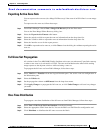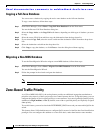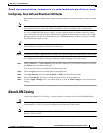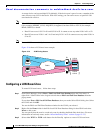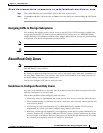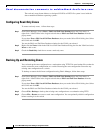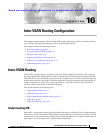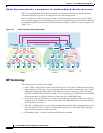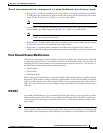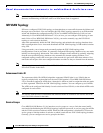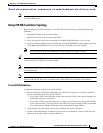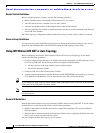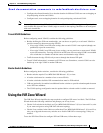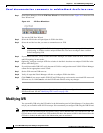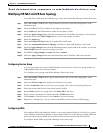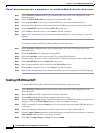
Send documentation comments to mdsfeedback-doc@cisco.com.
16-3
Cisco MDS 9000 Family Fabric Manager Configuration Guide
OL-6965-03, Cisco MDS SAN-OS Release 2.x
Chapter 16 Inter-VSAN Routing Configuration
Inter-VSAN Routing
• Edge VSAN—A VSAN that initiates (source edge-VSAN) or terminates (destination edge-VSAN)
an IVR path. Edge VSANs may be adjacent to each other or they may be connected by one or more
transit VSANs. In Figure 16-1, VSANs 1, 2, and 3 are edge VSANs.
Note An edge VSAN for one IVR path can be a transit VSAN for another IVR path.
• Transit VSAN—A VSAN that exists along an IVR path from the source edge VSAN of that path to
the destination edge VSAN of that path. In Figure 16-1, VSAN 4 is a transit VSAN.
Note When the source and destination edge VSANs are adjacent to each other, then a transit
VSAN is not required between them.
• Border switch—An IVR-enabled switch that is a member of two or more VSANs. Border switches
in Figure 16-1 span two or more different color-coded VSANs.
• Edge switch—A switch to which a member of an IVR zone has logged in. Edge switches are
oblivious to the IVR configurations in the border switches. Edge switches need not be IVR enabled.
Fibre Channel Header Modifications
IVR works by virtualizing the remote end devices in the native VSAN using a virtual domain. When IVR
is configured to link end devices in two disparate VSANs, the IVR border switches are responsible for
modifying the Fibre Channel headers for all communication between the end devices. The sections of
the Fibre Channel frame headers that are modified include:
• VSAN number
• Source FCID
• Destination FCID
When a frame goes from the initiator to the target, the Fibre Channel frame header is modified such that
the initiator VSAN number is changed to the target VSAN number. If IVR Network Address Translation
(NAT) is enabled, then the source and destination FCIDs are also translated at the edge border switch. If
IVR NAT is not enabled, then you must configure unique domain IDs for all switches involved in the
IVR path.
IVR NAT
Cisco MDS SAN-OS Release 2.1(1a) introduces IVR NAT, which allows you to set up IVR in a fabric
without needing unique domain IDs on every switch in the IVR path. When IVR NAT is enabled, the
virtualized end device that appears in the native VSAN uses a virtual domain ID that is unique to the
native VSAN.
Note IVR NAT requires Cisco MDS SAN-OS Release 2.1(1a) or later on all switches in the fabric performing
IVR. If you have isolated switches with an earlier release that are involved in IVR, you must remove any
isolated fabrics from monitoring by Fabric Manager server and then re-open the fabric to use IVR NAT.



